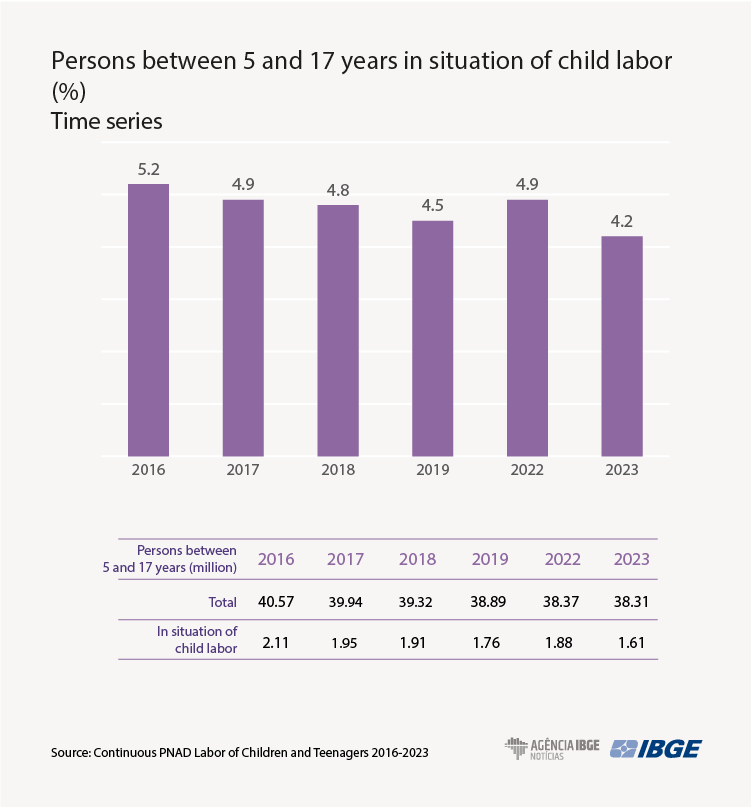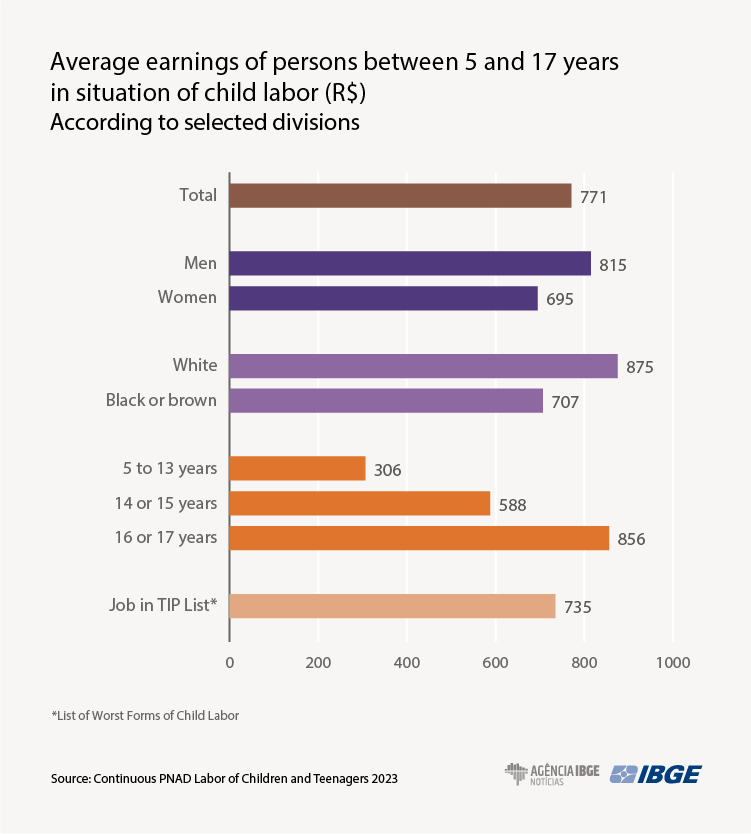Continuous PNAD
In 2023, child labor drops once again, hits lowest level in time series
October 18, 2024 10h00 AM | Last Updated: October 21, 2024 02h33 PM
Highlights
- Brazil had 1.607 million children and teenagers aged between 5 and 17 years in situation of child labor in 2023, the smallest contingent since 2016, when the time series of the Continuous PNAD began for this indicator. This contingent dropped 14.6% against 2022 (1.881 million) and 23.9% against 2016 (2.112 million).
- The proportion of children in child labor had interrupted the sequence of drops in the time series and had risen to 4.9% in 2022. In 2023, this indicator dropped once again, hitting 4.2%, the lowest percentage in the time series.
- The biggest contingent of children and teenagers aged between 5 and 17 years in situation of child labor was in the Northeast (506 thousand), though the highest proportion was in the North Region, in which 6.9% of children and teenagers aged between 5 and 17 years were in situation of child labor.
- Nearly two thirds (65.2%) of children and teenagers in child labor were either black or brown persons. This percentage surpassed the share of this group of color or race in the Brazilian population aged between 5 and 17 years (59.3%).
- Child labor moves children away from school. While 97.5% of the population aged between 5 and 17 years were students, this rate was 88.4% among child workers.
- In 2023, Brazil had 586 thousand children and teenagers aged between 5 and 17 years exerting the worst forms of child labor, which involved risk of accidents or were harmful to health and are described in the TIP List. This contingent was the smallest one in the time series and reduced 22.5% over 2022, when 756 thousand Brazilian children and teenagers were in this situation.
- Inequalities observed in the Brazilian labor market extend to the universe of the child labor. The average earnings of male child workers were R$815, whereas female child workers earned R$695. For black and brown persons in child labor, the average earnings were R$707 and R$875 for white persons in the same situation.
- The work in economic activities did not exempt children and teenagers from household tasks. Indeed, the proportion of those involved in household tasks was higher among those who worked (75.5%) than among those who did not exert any economic activity (51.7%).

In 2023, 1.852 million children and teenagers aged between 5 and 17 years worked in economic activities or in the production for self-consumption in Brazil. Of them, 1.607 million were in situation of child labor. For the International Labor Organization (ILO), child labor is that dangerful and harmful to the health and moral, social, physical or mental development of children and that interferes in their education. The concept of child labor takes into account the age range, activity type, hours worked, school attendance, risk and informality.
Gustavo Fontes, the analyst in charge of the annual module of the Continuous PNAD on Labor of Chidren and Teenagers aged between 5 and 17 years, clarifies: "Not every work in this age range is considered child labor. In the case of children aged between 5 and 13 years who work, all of them are in situation of child labor, as the Brazilian legislation bans any work to those under 16 years, except in the condition of apprentice from 14 years onwards. For those between 16 and 17 years, a formal contract is mandatory, except for night, dangerful or harmful work. As a result, not all teenagers aged between 14 and 17 years are in situation of child labor. For each age range, it is required to assess the nature and condition in which the work is exerted, including the work hours and school attendance."
The contingent of children in situation of child labor (1.607 million) dropped 14.6% in 2023 against 2022 (1.881 million). The time series of the Continuous PNAD for the population in siatuation of child labor was the following: 2016 (2.112 million), 2017 (1.945 million), 2018 (1.905 million) and 2019 (1.758 million). It was not possible to collect the information on the work of children and teenagers in 2020 and 2021 due to the Covid-19 pandemic.
The proportion of children and teenagers aged between 5 and 17 years in situation of child labor was 5.2% in 2016 and changed to 4.5% in 2019. In 2022, it interrupted the sequence of drops observed in the time series and rose to 4.9%. In 2023, this indicator dropped once again, hitting 4.2%, the lowest percentage in the time series.
Gustavo Fontes, the analyst in charge of this module of the Continuous PNAD, notes: "The period between 2022 and 2023 registered an important drop - of more than 14% - in the contingent of children and teenagers in situation of child labor, hitting the lowest level in the time series of the survey. This drop occurred in every age range."

Child labor hits 14.6% of teenagers between 16 and 17 years
The occurrence of child labor tends to grow with the age. In 2023, it was 1.3% for persons aged between 5 and 13 years and rose to 6.2% in the group between 14 and 15 years, reaching 14.6% among teenagers between 16 and 17 years. However, the percentage of children in child labor decreased in every age group in relation to 2022.
Nearly 55.7% of the population in situation of child labor (or 895 thousand persons) were aged between 16 and 17 years; 22.8% (366 thousand persons) were aged between 14 and 15 years and 21.6% (346 thousand persons), between 5 and 13 years.
Northeast has half million children adn teenagers in child labor
The biggest contingent of children and teenagers aged between 5 and 17 years in situation of child labor was in the Northeast (506 thousand), followed by the Southeast (478 thousand persons), North (285 thousand persons), South (193 thousand persons) and Central-West (145 thousand persons).
The North had the highest proportion of children and teenagers in this situation: 6.9% of its population aged between 5 and 17 years. The Central-West (4.6%) and Northeast (4.5%) also surpassed the national average (4.2%), whereas the Southeast (3.3%) and South (3.8%) had the lowest proportions.
Compared with 2022, the contingent of children and teenagers in child labor reduced in all the regions, with a lower intensity in the North (from 299 thousand to 285 thousand persons) and Central-West (from 157 thousand to 145 thousand persons). Compared with 2016, all the regions reduced, except for the Central-West, which remained close to stability.
Fontes reminds that "in relation to 2016, the fist year of the time series, the Northeast and South regions recorded a steeper reduction in the number of child workers, with a drop of nearly 33% in the total number of children adn teenagers in situation of child labor in each one of these regions."
Out out of five child workers work 40 hours or more per week
The number of weekly hours of 39.2% of children and teenagers in situation of child labor was up to 14 hours, whereas 20.6% worked 40 hours or more.
The number of weekly hours worked increases with the age. In the group aged between 5 and 13 years, more than 80% of children and teenagers worked up to 14 hours. In the group aged between 16 and 17 years, 19.7% worked up to 14 hours, whereas 31.1% worked 40 hours or more.
Nearly two thirds of child workers are either black or brown
In Brazil, 51.2% of the population between 5 and 17 years is male. However, this proportion rises to 63.8% in the population in situation of child labor.
In 2023, 3.6% of white children and teenagers were in child labor, a lower percentage than that of black and brown children and teenagers (4.6%) in this situation.
The proportion of white persons among chile workers (33.8%) was lower than its share in the Brazilian population between 5 and 17 years (39.9%). On the other hand, the proportion of black and brown persons in child labor (65.2%) surpassed its share in the same age group (59.3%).
Child labor reduces school attendance
While 97.5% of the population aged between 5 and 17 years were students, this rate was lower among child workers (88.4%).
This difference varies according to the age, being the biggest gap among persons between 16 and 17 years: 90.0% of the population in this age group attended school against only 81.8% of the child workers within this age range.
"Among the younger persons, between 5 and 13 years, schoold attendance (percentage of students in this population) is virtually universal, in any situation. However, with the age, school attendance is greater among persons in situation of child labor," highlighted Fontes.
Trade and agriculture concentrate 48.3% of child labor
Most children and teenagers in child labor worked either in Trade and repair of vehicles (26.7%) or Agriculture, livestock, forestry, fishing and aquaculture (21.6%), followed by Lodging and feeding (12.6%), Overall industry (11.0%) and Domestic services (6.5%). The other groups added up to 21.6%.
Child workers were mainly in non-agricultural activities (78.4%), either as employees (62.8%), assisting family workers (24.3%), self-employed or employers (12.8%).
The proportion of teenagers aged between 16 and 17 years in informal jobs retreated to 73.4% of those who accomplished economic activities in this age group, or 751 thousand persons. It was the lowest informality rate in the time series, which had hit its peak (76.5%) in 2022. In 2016, the informality rate of this age group was 75.3%.
Brazil has 586 thousand children and teenagers in the worst forms of child labor (TIP List)
In 2023, 586 thousand children and teenagers aged between 5 and 17 years exerted the worst forms of child labor, or 41.1% of children and teenagers who accomplished economic activities. Among the children and teenagers in the worst forms of child labor, 76.4% were male persons and 67.5% were either black or brown persons.
The contingent of child workers on the TIP List was the biggest one in the time series (586 thousand persons) in 2023, retreating 22.5% over 2022, when 756 thousand children and teenagers were in this situation. In 2016, 926 thousand Brazilian children exerted the worst forms of child labor.
For Fontes, "the significant retreat in the number of children and teenagers inserted in the worst forms of child labor is a quite relevant information, since that the type of jobs exerted and associated occupational risks might jeopardize the safety, health and development of children."
Between 2016 and 2023, the percentage of children and teenagers in the worst forms of child labor in the population between 5 and 17 years that accomplished economic activities retreated from 51.3% to 41.1%, the lowest rate in the time series.
The worst forms of child labor hit the younger: 65.7% of children and teenagers aged between 5 and 13 years who accomplished economic activities exerted jobs in the TIP List. This percentage was 55.7% in the group between 14 and 15 years. Among teenagers between 16 and 17 years, 34.1% were in this condition.
Earnings from child labor are lower, those from TIP List, even lower
In 2023, the real monthly average earnings usually received from all jobs of persons aged between 5 and 17 years who accomplished economic activities was R$836. The monthly earnings were R$771 for persons within this age group in child labor. For those not classified in child labor, the value was R$1,074. On the other hand, the average earnings of the population involved in dangerful child labor (TIP List) was R$735 per month, lower than the other groups.
The average earnings of male child workers was R$815, whereas the female ones received R$695. Among black and brown persons, the average earnings were R$707, increasing to R$875 among white persons. Earnings grew according to age: they were R$306 in the group between 5 and 13 years and R$856 in the group between 16 and 17 years.
Child labor prevails in poorer households. The per capita household real monthly average earnings in the households with at least one persons aged between 5 and 17 years in situation of child labor were R$1,051, lower than the value registered in households that also had residents within this age range, though no one of them in situation of child labor (R$1,297).

Earnings of student workers were R$731, and R$979 for those not attending school. Such gap of earnings might reflect age differences of these two groups, as well as the number of hours dedicated to labor.
Bolsa Família assists children and teenagers with the lowest per capita earnings
In 2023, nearly 13.6 million children and teenagers aged between 5 and 17 years lived in households benefited from Bolsa Família, the equivalent to 35.6% of this age group.
Among the households with children and teenagers between 5 and 17 years, regardless of the situation of child labor, the per capita household monthly earnings of those receiving Bolsa Família (R$554) were one third of the earnings of those not benefited (R$1,618).
Among children and teenagers between 5 and 17 years, 3.7% accomplished economic activities. In the households benefited from Bolsa Família, the predominance was slightly lower: 3.4% of children and teenagers (or 466 thousand) accomplished economic activities.
However, 94.4% of the persons aged between 5 and 17 years who accomplished economic activities and lived in households benefited from the program were in situation of child labor, a percentage above that recorded in th total number of children who accomplished economic activities (82.8%).
Working does not exempt children and teenagers from domestic tasks
Among 38.3 million children and teenagers aged between 5 and 17 years in Brazil, 52.6% (20.1 million) accomplished domestic tasks or took care of persons in 2023. The survey shows that the work in productive activities did not move children adn teenagers away from domestic tasks. Indeed, the proportion of children and teenagers involved in domestic tasks was higher among those who worked.
Nearly 75.5% of children and teenagers in economic activities also accomplished domestic tasks and/or care of persons. The proportion was 51.7% among those that did not accomplish economic activities. Among children and teenagers in situation of child labor, 79.3% also accomplished domestic tasks and/or care of persons.
"Therefore, not only the work in productive activities did not save a good part of children and teenagers from these domestic tasks, but the percentage of persons who accomplished these tasks was higher among those employed, espacially among the younger ones," notes the IBGE analyst.
More about the survey
The Continuous PNAD Labor of Children and Teenagers aged between 5 and 17 years captures information about economic activities and production for self-consumption, as well as about school activities and domestic tasks and care of persons accomplished by this age group. It also includes information on children and teenagers who accomplish labor from the List of the Worst Forms of Labor (TIP List). The scope of the survey is national, with some disaggregations by Major Region.



















